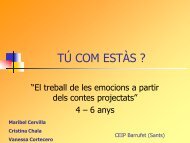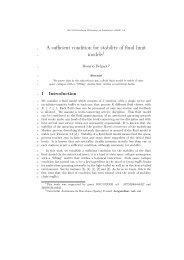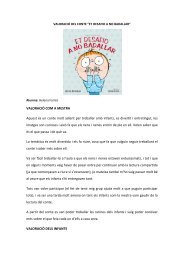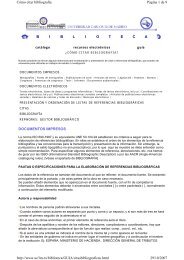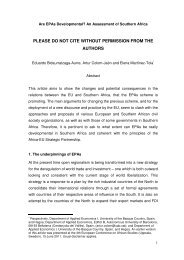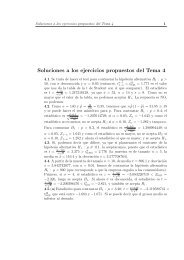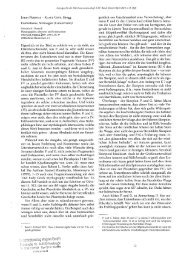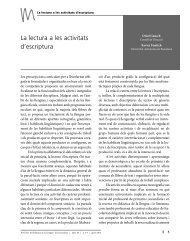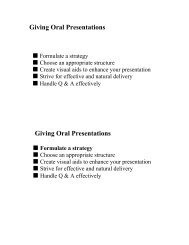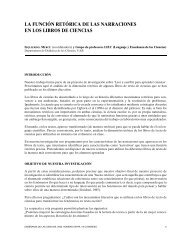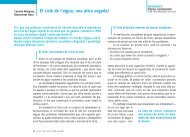J. Theor. Biol. 2006 - PÃ gines de la UAB
J. Theor. Biol. 2006 - PÃ gines de la UAB
J. Theor. Biol. 2006 - PÃ gines de la UAB
- No tags were found...
You also want an ePaper? Increase the reach of your titles
YUMPU automatically turns print PDFs into web optimized ePapers that Google loves.
248<br />
ARTICLE IN PRESS<br />
J.F. Fontanari et al. / Journal of <strong>Theor</strong>etical <strong>Biol</strong>ogy 239 (<strong>2006</strong>) 247–256<br />
competing temp<strong>la</strong>tes: additional assumptions regarding<br />
cooperation between temp<strong>la</strong>tes are mandatory to overcome<br />
this impasse.<br />
Most proposals to circumvent the information crisis<br />
have conformed to the limitation of information co<strong>de</strong>d by<br />
a single temp<strong>la</strong>te, focusing instead on the conditions that<br />
guarantee the stable coexistence of different temp<strong>la</strong>tes (for<br />
rare exceptions, see Scheuring, 2000; Szabo´ et al., 2002).<br />
Since the total information content is the product of the<br />
number of different temp<strong>la</strong>tes and the maximum information<br />
co<strong>de</strong>d per temp<strong>la</strong>te, provi<strong>de</strong>d the temp<strong>la</strong>te types have<br />
the same concentration, ensuring the coexistence of<br />
different temp<strong>la</strong>tes resolves the information crisis. In this<br />
vein, Eigen (1971) and Eigen and Schuster (1979) proposed<br />
the hypercycle, i.e. a catalytic feedback network in which<br />
each temp<strong>la</strong>te helps in the replication of the next one, in a<br />
secondary cycle closing on itself (second-or<strong>de</strong>r autocatalysis).<br />
Originally, the enzymatic function (i.e. replicase<br />
activity) was thought to be carried out by the enco<strong>de</strong>d<br />
proteins (the ‘‘realistic’’ hypercycle: Eigen and Schuster,<br />
1979), but recently also the hypercycle is projected into the<br />
RNA world (Gilbert, 1986), with RNA molecules acting as<br />
temp<strong>la</strong>tes as well as enzymes (cf. Zintzaras et al., 2002).<br />
This view gained p<strong>la</strong>usibility when the ability of polynucleoti<strong>de</strong>s<br />
to exert various catalytic (enzymatic) functions<br />
was discovered (see Doudna and Szostak, 1989; Doudna<br />
and Lorsch, 2005 for review). However, if the number of<br />
hypercycle members is greater than four, the temp<strong>la</strong>te<br />
concentrations will vary with time (Eigen and Schuster,<br />
1979), periodically <strong>de</strong>creasing to very small values, thus<br />
making <strong>la</strong>rge hypercycles vulnerable to extinction via<br />
fluctuations (Nun˜o and Tarazona, 1994). The information<br />
gain due to the coexistence of different temp<strong>la</strong>tes in the<br />
hypercycle is then not significant. In addition, the hypercycles<br />
have attracted criticisms for other reason: as first<br />
pointed out by Maynard Smith (1979), giving catalytic<br />
support in such molecu<strong>la</strong>r networks is in fact an altruistic<br />
behaviour and so hypercycles are easy targets to parasites,<br />
i.e. molecules that do not reciprocate the catalytic support<br />
they receive. To solve the conundrum of dynamic coexistence<br />
of different temp<strong>la</strong>tes Szathma´ry and Demeter<br />
(1987), e<strong>la</strong>borating on the package mo<strong>de</strong>l proposed by<br />
Niesert et al. (1981), <strong>de</strong>scribed the ‘‘stochastic corrector<br />
mo<strong>de</strong>l’’ as an effective treatment against parasites and of<br />
the conflict among genes due to internal competition;<br />
namely, the compartmentalization or packaging of unlinked<br />
temp<strong>la</strong>tes that are replicated by genes with a nonspecific<br />
replicase functionality in iso<strong>la</strong>ted vesicles that<br />
reproduce by clonal selection (see also Grey et al., 1995), so<br />
that infected vesicles simply die out preventing the<br />
spreading of the mutant parasites to the healthy ones<br />
(but see Santos et al., 2003).<br />
Since the interaction of temp<strong>la</strong>tes within vesicles is<br />
essentially competitive and the vesicle dynamics, usually<br />
fission, would eventually lead to the loss of essential genes<br />
for survivorship (i.e. the assortment load), some sort of<br />
selection at the vesicle or compartment level is obviously<br />
required for these mo<strong>de</strong>ls as an alternative to hypercycles<br />
(see, e.g. Niesert et al., 1981; Szathma´ry and Demeter,<br />
1987; Alves et al., 2001; Zintzaras et al., 2002; Hogeweg<br />
and Takeuchi, 2003). However, although the coexistence of<br />
a few distinct temp<strong>la</strong>tes has been <strong>de</strong>monstrated for sure, a<br />
common criticism is that the package mo<strong>de</strong>l is a very<br />
sloppy system of information integration because the<br />
major difficulty for conserving a complete set of genes is<br />
the growth difference between replicators (e.g. Suzuki and<br />
Ono, 2003). Thus, in the mo<strong>de</strong>l of Niesert et al. (1981), the<br />
number of different temp<strong>la</strong>tes per compartment cannot<br />
exceed three given a realistic parameter setting. Therefore,<br />
although conceptually simpler than the hypercycles it is not<br />
clear whether the information content of the package<br />
mo<strong>de</strong>ls could be substantially <strong>la</strong>rger than the information<br />
content in the free-temp<strong>la</strong>te case. Simi<strong>la</strong>r to the package<br />
mo<strong>de</strong>l of Niesert et al. (1981) and the stochastic corrector<br />
mo<strong>de</strong>l (Szathma´ry and Demeter, 1987) we assume here that<br />
the temp<strong>la</strong>tes are replicated by a non-specific replicase.<br />
How this replicase evolved is a serious problem we leave<br />
open as there is no currently known metabolic path to<br />
RNA in pre-biotic settings, and the attainment of a fully<br />
functional RNA replicase is a very difficult enterprise<br />
(Johnston et al., 2001). Also, we do not know how many<br />
different temp<strong>la</strong>tes (genes) can coexist in the packages.<br />
In comparison with the hypercycle, very little is known<br />
about the dynamics and steady states of package mo<strong>de</strong>ls,<br />
since their greater complexity frustrates any attempt to<br />
carry out a thorough analysis of the space of parameters<br />
that <strong>de</strong>termine the evolution of temp<strong>la</strong>tes and vesicles. To<br />
bypass this difficulty, here we study a package/compartment<br />
mo<strong>de</strong>l using the discrete-time mathematical formalism<br />
of group selection (Eshel, 1972; Levin and Kilmer,<br />
1974; Aoki, 1982; Silva and Fontanari, 1999) in which a<br />
countable infinity of groups (vesicles, in the case) are<br />
iso<strong>la</strong>ted from each other (see, e.g. Wa<strong>de</strong>, 1978; Boorman<br />
and Levitt, 1980 for reviews). The total number of<br />
temp<strong>la</strong>tes confined in a vesicle is finite and is the same<br />
for all vesicles. Because of random genetic drift, this feature<br />
implies that in the absence of group selection (differential<br />
extinction <strong>de</strong>pending on the internal temp<strong>la</strong>te composition<br />
of the group) only one type of temp<strong>la</strong>te will be present in a<br />
given vesicle in the equilibrium regime. Of course, the<br />
surviving temp<strong>la</strong>te type may not be the same in different<br />
vesicles. Hence, by barring the coexistence of distinct<br />
temp<strong>la</strong>tes in the same vesicle, random drift p<strong>la</strong>ys a simi<strong>la</strong>r<br />
role as the temp<strong>la</strong>te assortment procedure of the stochastic<br />
corrector mo<strong>de</strong>l. Here, a group is viewed as an iso<strong>la</strong>ted set<br />
of temp<strong>la</strong>tes that maintains its integrity during its entire<br />
existence. This view contrasts with the ephemeral groups of<br />
Wilson’s (1980) formu<strong>la</strong>tion wi<strong>de</strong>ly used in pre-biotic<br />
evolution (Michod, 1983; Donato et al., 1997; Alves<br />
et al., 2001) and viral dynamics (Szathma´ry, 1992) in<br />
which the group structure is dissolved each generation to<br />
form a global mating pool; but comes close to the<br />
stochastic corrector mo<strong>de</strong>l. In particu<strong>la</strong>r, in the transient<br />
‘‘group’’ formu<strong>la</strong>tion random drift p<strong>la</strong>ys no role at all,



